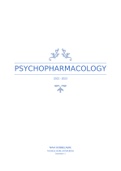Resume
Psychopharmacology samenvatting 2022/2023
- Cours
- Psychopharmacology
- Établissement
- Thomas More Hogeschool (tmhs)
Dit is een Engelstalige samenvatting van het vak Psychopharmacology. Deze bevat informatie uit de powerpoints, mijn notities en de meeste teksten (verplichte literatuur).
[Montrer plus]












